How to Store an Axe the Right Way
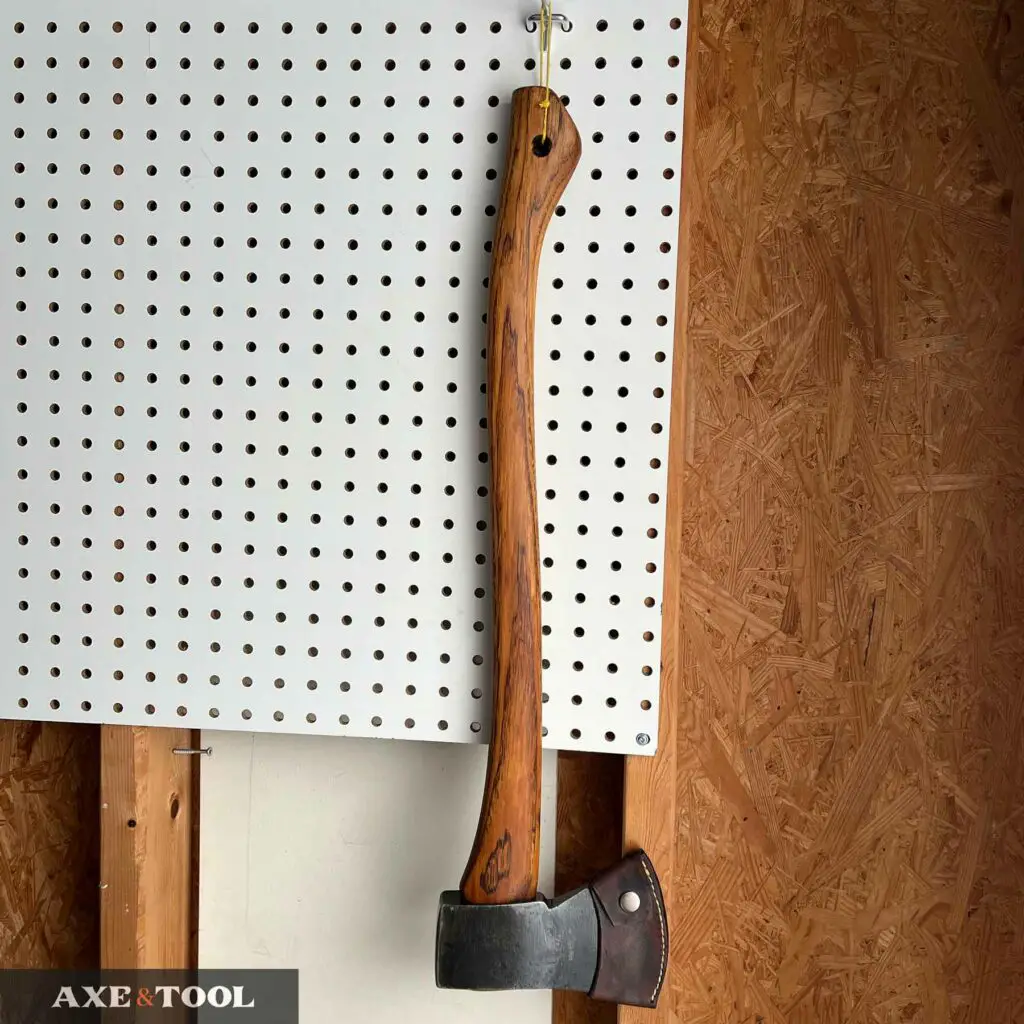
Proper storage is key to maintaining your axe and keeping it chopping for years. Luckily, it’s not hard to store an axe correctly.
An axe should be stored clean, oiled, and in a climate-controlled environment. Temperature and humidity changes can cause rust, brittleness, and warp, crack, or loosen the handle. It’s best to store an axe off the floor by either the head or a lanyard on the handle.
I keep mine in a basement store room, as my wife tells me axes should not be stored under the bed, on the dining table, in the bathroom, on top of the fridge, or in the kid’s rooms.
This is just a hobby, but if you buy through a link I may get a commission that supports the site. Thanks!
Prepare Your Axe for Storage
A quick wipe down after use and a little bit of care at the end of the season is important for maintaining your axe and keeping it chopping for years.
Clean & Oil the head to Prevent Rust
Clean any dirt and natural material off the axe head as it contains moisture that will cause rust if left on your blade. This can often be removed with oil, but you can use steel wool for stubborn grime.
Once the head is clean give it another quick wipe-down oil to prevent moisture in the air from causing rust. Any oil (like WD-40) will do, but for extra protection, I often use heavier oil or wax for long-term storage. If you want to know more I have a separate article on how to rustproof your axe.
Oil the Handle for Long Term Storage
You don’t need to oil your handle every time you use your axe. But at the end of the season, or every 6 months it’s good to add another thin coat of Boiled Linseed Oil to maintain the wood. A well-oiled handle can better withstand temperature and humidity changes and is less likely to come loose. I have a full guide on the best practices for oiling your axe handle.
Put a Sheath on it
Store your axe in its sheath, it’s safer and it protects the blade from the elements. It’s always best practice, but some methods are fine without it. Just make sure if you have been out in the field that your sheath has had a chance to fully dry.
Don’t store your axe in the little rubber sleeve that sometimes comes on the blade. Those will actually trap moisture from the air and lead to rust (I found out the hard way).
Tip: Like with the handle, you should condition a leather sheath at end of every season to make sure the leather stays strong, soft, and water-resistant. The brand doesn’t matter, but I like Fiebing’s Aussie Conditioner (amazon) – it’s thicker and adds great water resistance.
Where to Store an Axe
It’s best to store an axe indoors in a climate-controlled environment, not just in a shed. Seasonal changes can be drastic, but even temperature and humidity changes in the morning and evening can cause condensation and start forming rust quickly.
Tip: Cold steel becomes brittle, so using an axe stored somewhere cold in the winter can damage it – especially if it’s being used on equally cold/frozen wood.
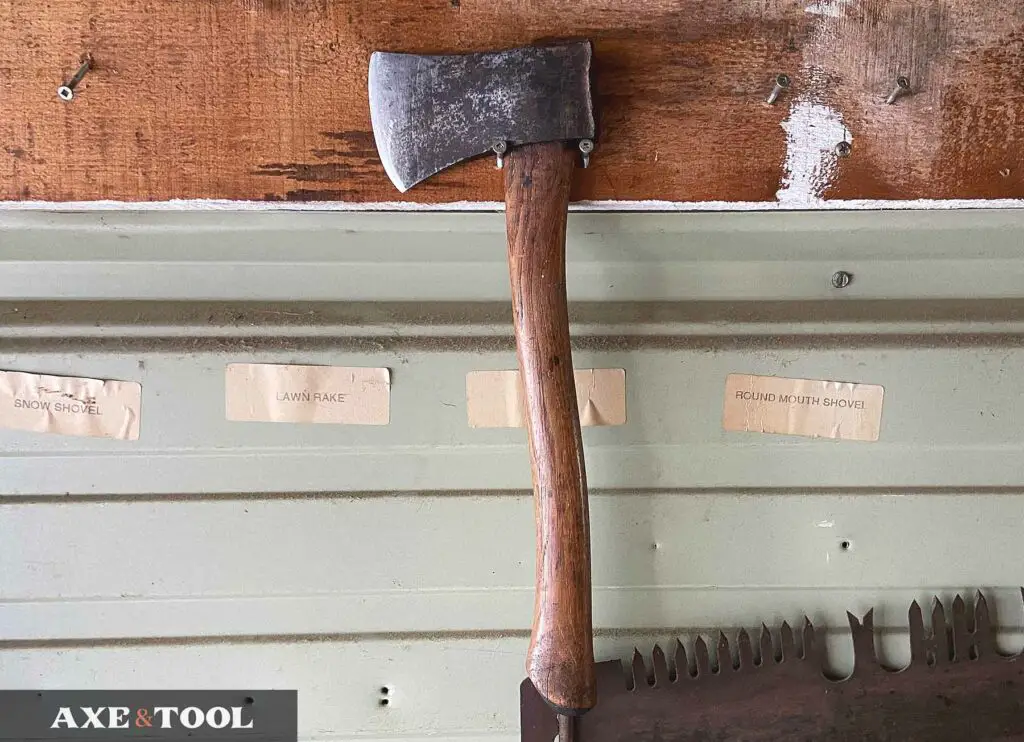
An uninsulated garage may be fine for preventing rust but can still be too harsh for a wood-handled axe if you live somewhere with significant seasonal weather changes.
Wood has fibers that shrink in the cold and expand in the heat. Prolonged exposure to these climate changes will loosen the handle as the fibers get damaged when they swell in the heat and then shrink and shift in the cold. The wood will also dry and can crack.
Short-term exposure isn’t going to be a problem – axes are meant to spend time outside, and a well-oiled handle can better resist these environmental changes. But months or years of storage like this can take a toll.
How to Store Your Axe
There are lots of ways to store an axe, but here are the basic methods.
1. Do not lean an axe against a wall
Leaning an axe against a wall can warp or bend the handle over time. The longer the axe, the more of an issue this can be. This is probably the most common mistake of axe storage, as it’s so easy to do.
If you do put your axe down (it happens all the time) – try and place it flush against a wall so the axe is standing straight or with the head resting on something so there is no pressure on the handle. And put a sheath on it, and make sure the blade is pointed in the safest direction.
2. A Lanyard is a Great Way to Store an Axe

Many axes have a hole in the palm swell that will allow you to add a small string or lanyard so you can hang your axe on the wall. This means no sideways pressure on the handle and the weight of the head is evenly distributed around the eye. It also gets the head is off the floor and away from dirt and moisture.
It is essential you have a sheath for this storing method.
I don’t use leather or paracord for the lanyard, they are too thick and get in the way during use. I have started using mason twine. It’s thin, tough, and bright neon (easy to see in the woods). It’s on Amazon, but I think I got mine from the dollar store.
Tip: The lanyard hole often gets mistaken for somewhere to add a wrist strap. You should NEVER put a wrist strap on your axe – it’s dangerous (here’s why).
3. Hang by The Head
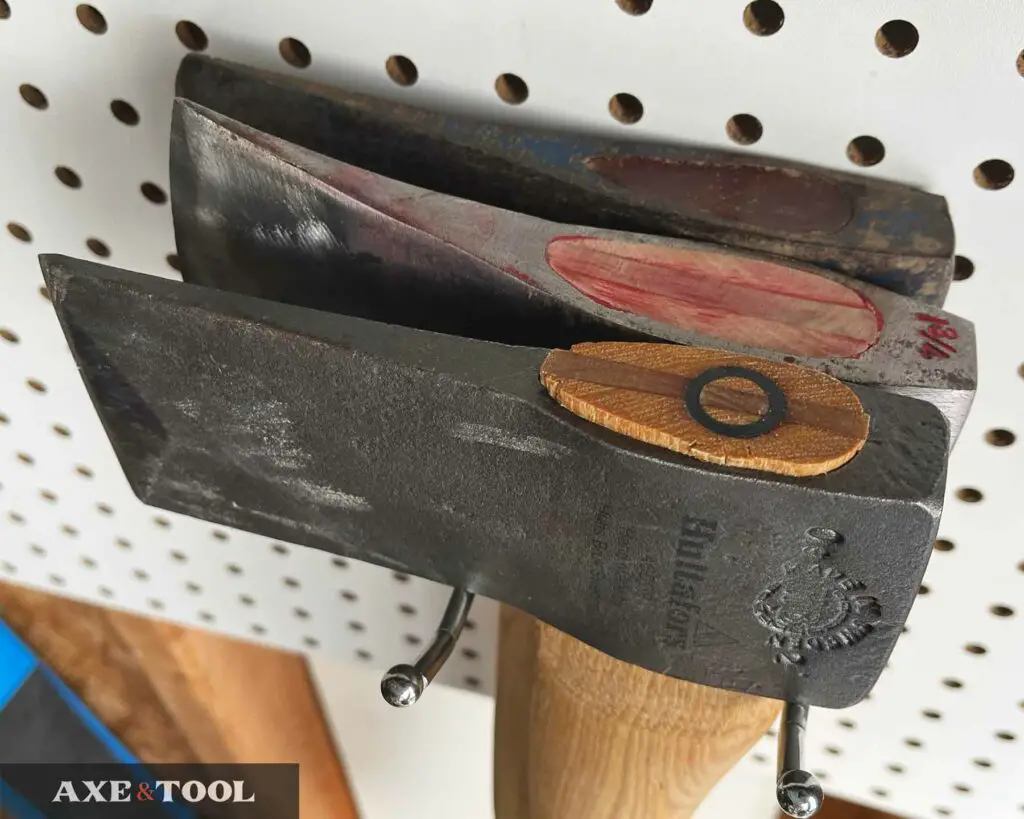
Just add support under each side of the head. This can easily be done with two nails, a bracket from the hardware store, a couple of pieces of wood, or a pegboard as shown above.
The axe can easily and quickly be taken down and put back up and stored with your other yard or shop tools. It gets it off the floor, takes the pressure off the handle, and evenly distributes pressure on both ends of the eye.
4. Displaying Axes on the Wall
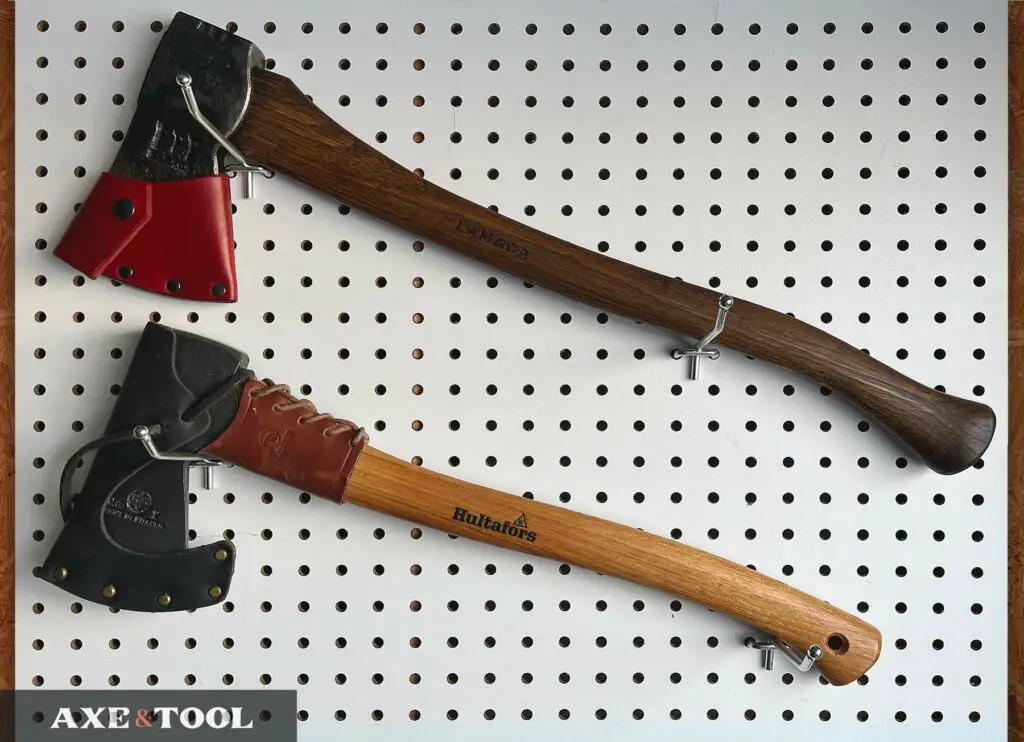
This is exactly the same process as above, but you are going to hang the axe sideways. One post needs to go right beneath the head, and the second should support the grip end of the handle.
This isn’t as space-efficient, but it looks great for display.
5. Hanging axes on a ledge
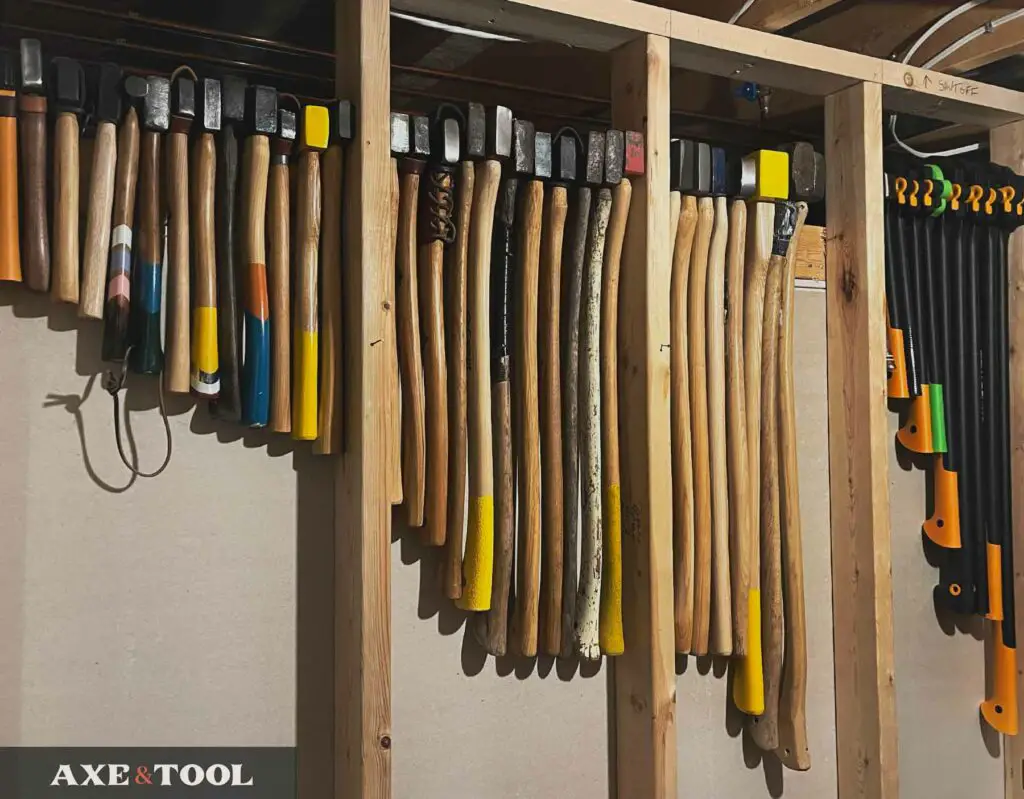
The nice thing about axes is the bottom of the blade almost always angles downward, so they are very easy to hook over a ledge. In the picture above, they are hanging on an unfinished basement wall, and the wall keeps the axe straight.
The handle also needs to be supported, so if I had mounted a ledge in front of the studs – I would have also needed to add one below to stop the handles from spinning in.
Not everyone will have or need this option, but it’s a very efficient way of storing axes.
6. Use an Axe Rack
Axe racks allow you to store a bunch of axes without having to drill into your wall. They are very easy to make, and I have a few design options below.
Alternative: I have also seen secondhand gun racks used for axe displays.
Axe Rack Designs
There are three pretty simple go-to designs for making your own axe rack. I don’t have full instructions, but you can see how they work below and figure them out based on your needs.

Vertical Axe Stand
This is one of the most common types of racks as it is incredibly easy to build with basically just 2x4s.
It’s very secure, as the axes must be removed from the top.

Titled Axe Stand
This design acts like the ledge method shown earlier and is handy because you can quickly grab an axe and go.
I recommend offsetting the supports slightly so the bottom support is closer to you to better secure the axe on the rack.
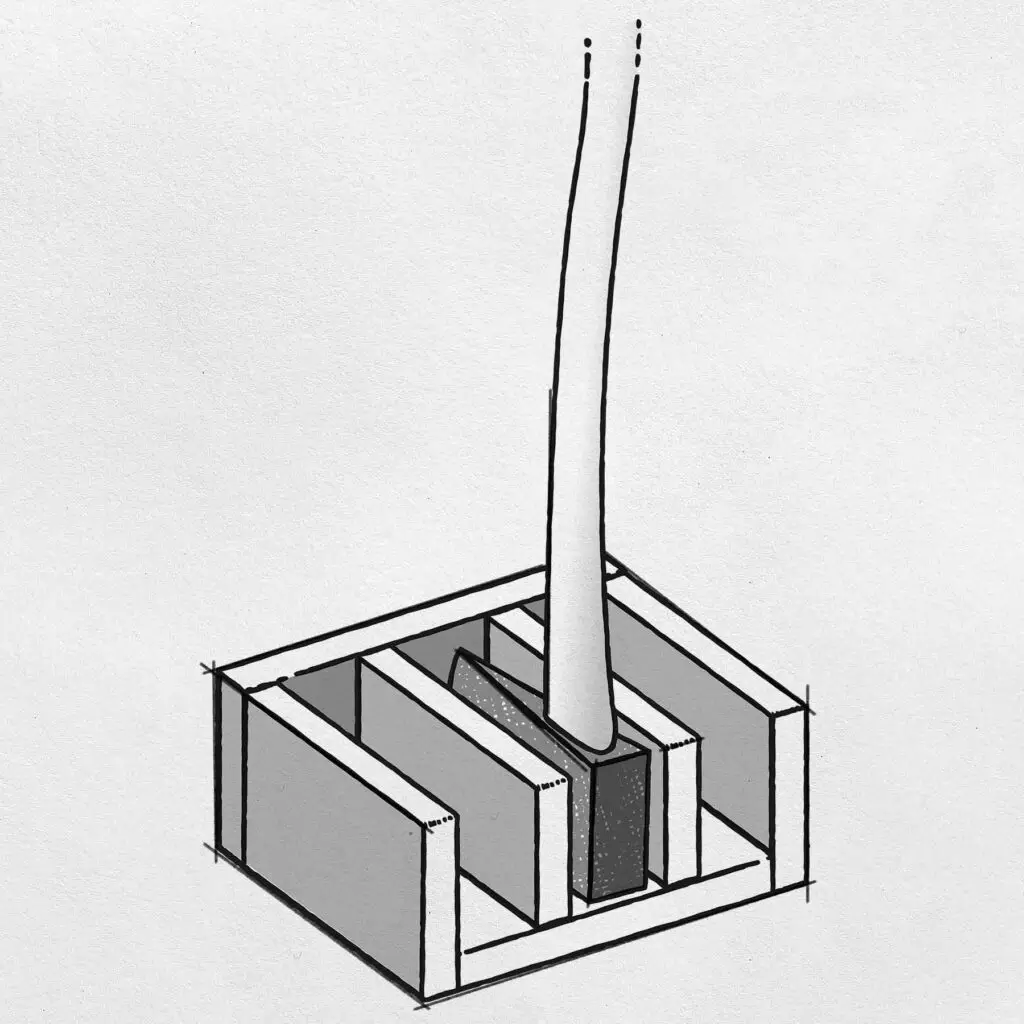
Floor Display
This straightforward design sandwiches the axe head so it stands straight and no pressure is put on the handle.
An additional piece could be added to the top or front to stop the axes from getting knocked out.
Vehicle Axe Storage
Like a shed, a vehicle is not air-tight or climate-controlled, so long-term storage can be hard on an axe. So it’s best to keep the axe in a bag or wrapped in/under something like a blanket to prevent most of the moisture in the air from reaching the axe. This will stop (or at least slow) condensation, and rust and handle damage.
If you need a permanent vehicle axe, get one with a composite handle – like Fiskars or Husqvarna. I have a full article about this topic here, with some recommended axes.
Campsite Axe Storage
When you are camping you should store your axe covered in your vehicle or your tent at night to prevent morning dew and condensation from covering it. A few nights outside won’t seriously harm an axe, but the raised grain from moisture and potential for rust will just mean more work for you when you get home.
Please comment below If I missed something or if you have any questions. I do my best to respond to everyone.
About the author:
About the author:
Jim Bell | Site Creator
I’m just a guy who likes axes. I got tired of only finding crap websites, so I set out to build a better one myself.
I’m also on Instagram: @axeandtool


I really like the bracket set from Lee Valley. Great site, by the way. I am a carver mostly but am learning how to cut down trees from my pastor, of all things. Great workout for a 60+!
I have been eyeing that set from Lee Valley for years, I just have too many axes and not enough space. As for chopping, it’s a great workout for anyone. Thanks for the comment!